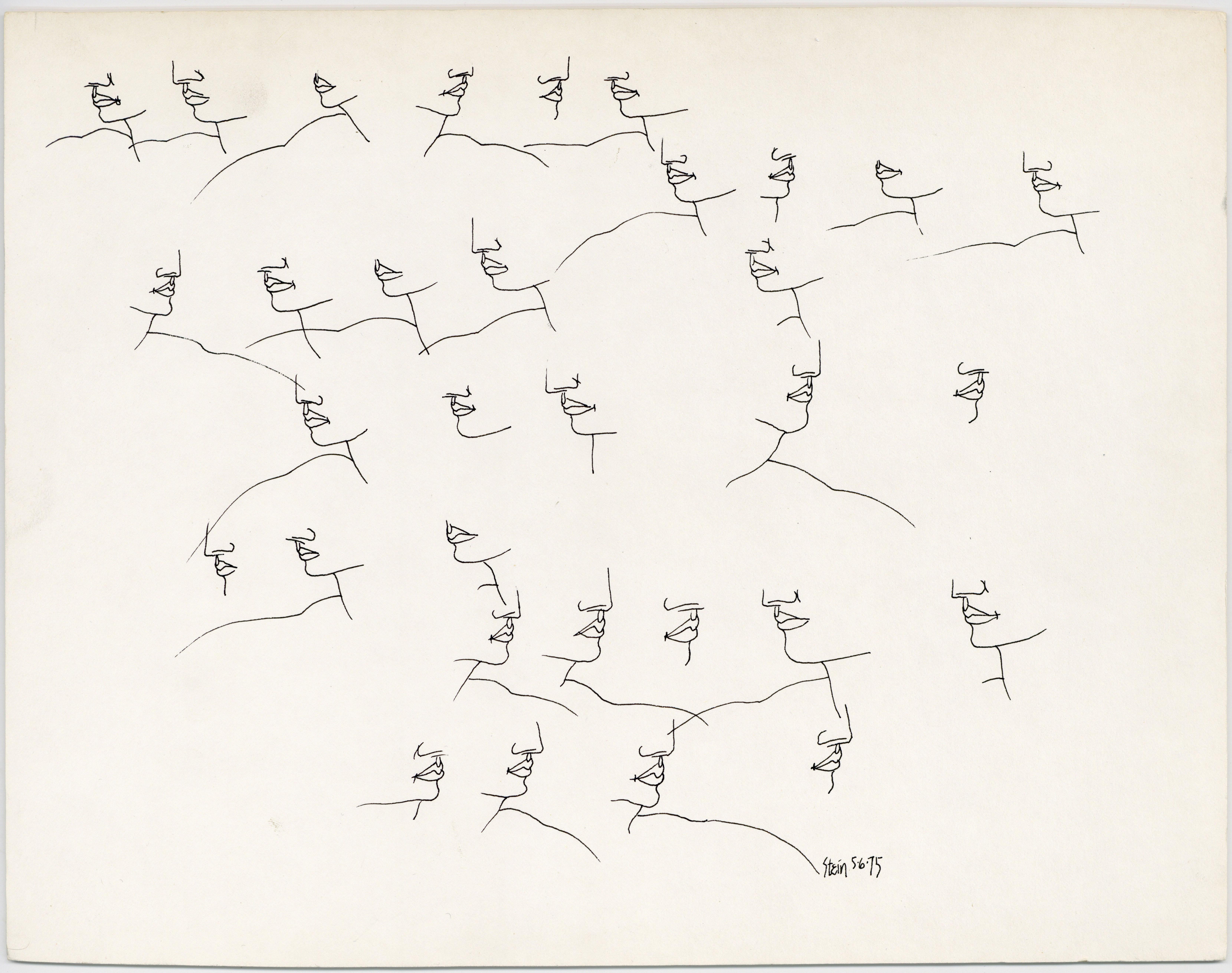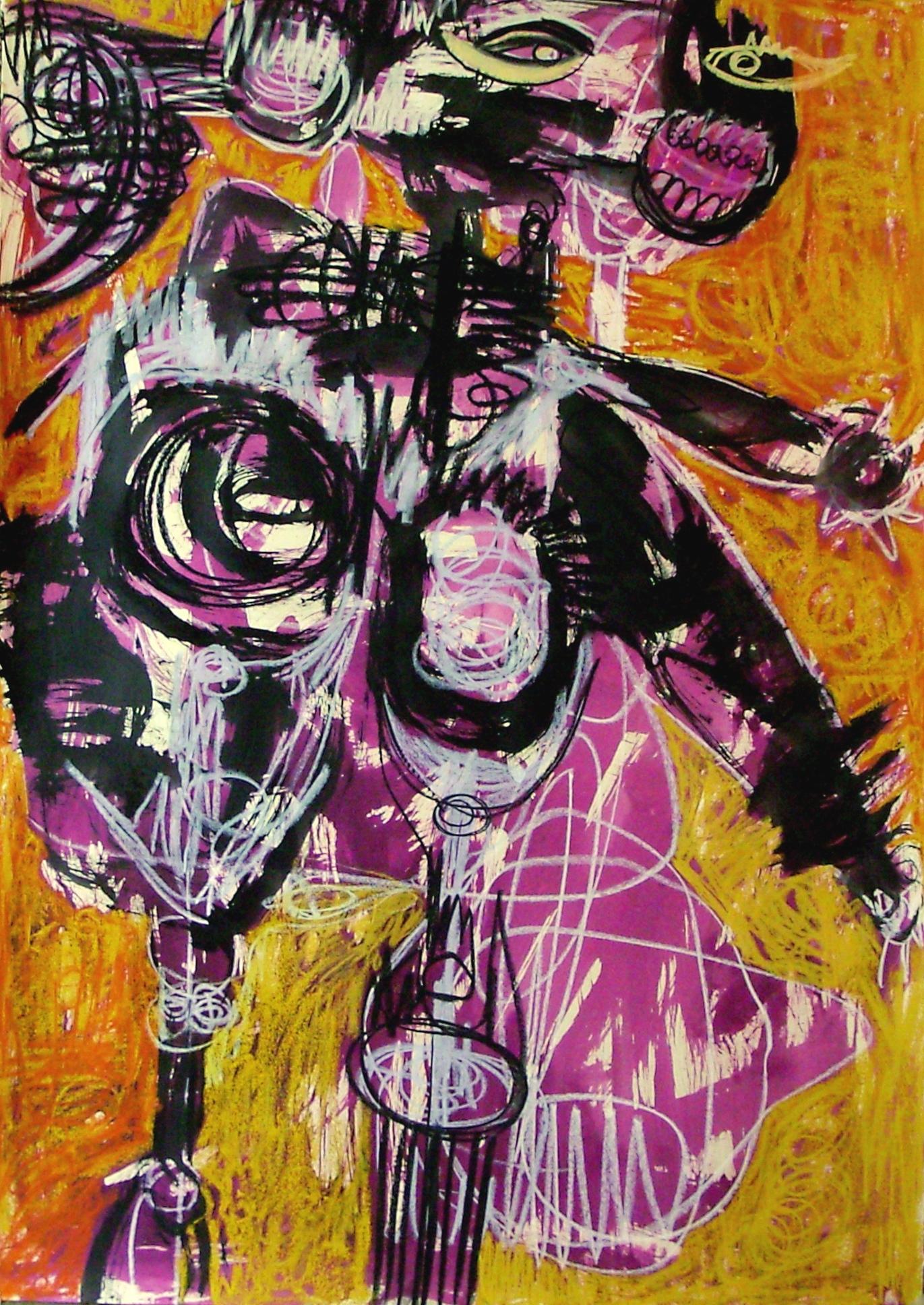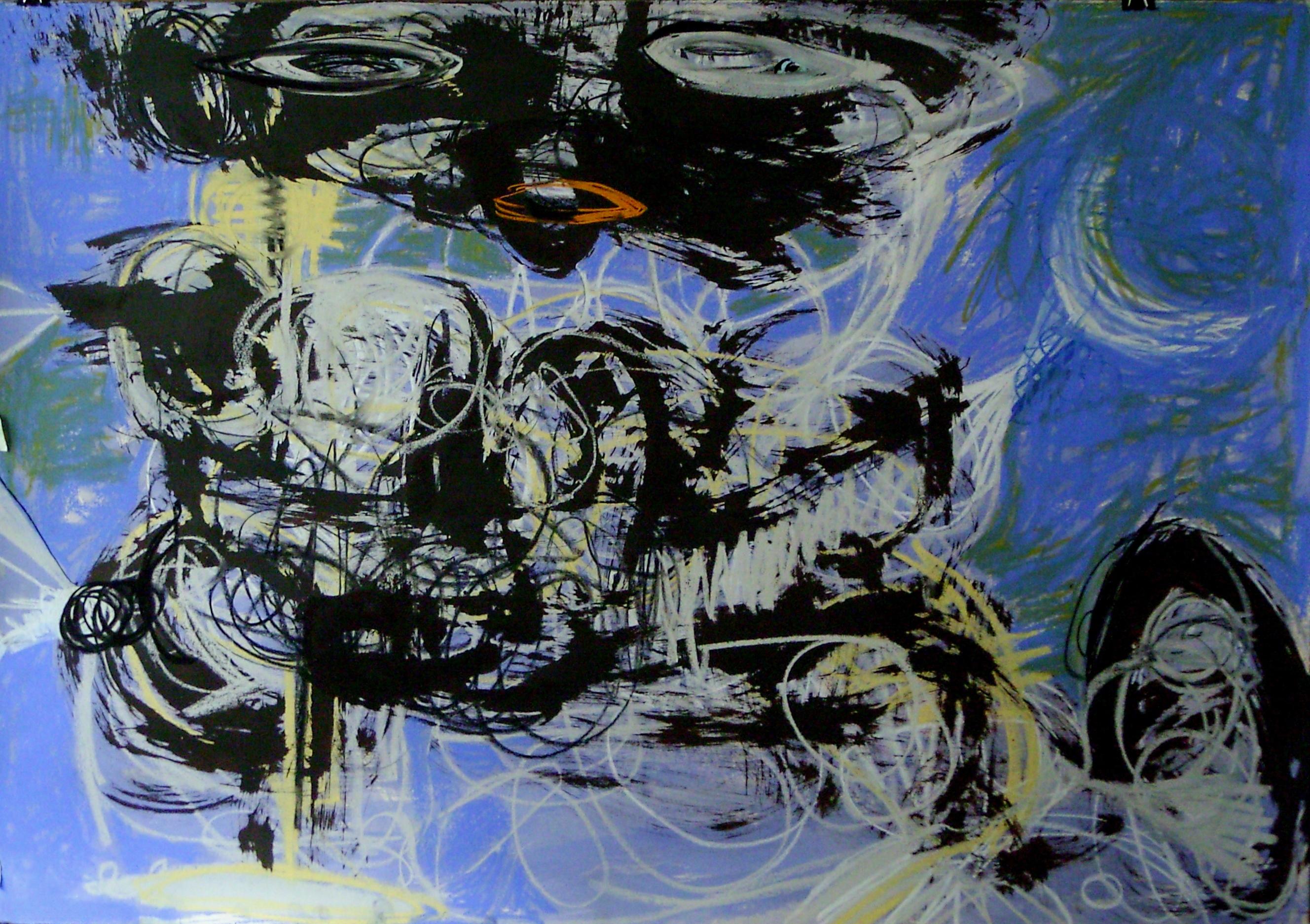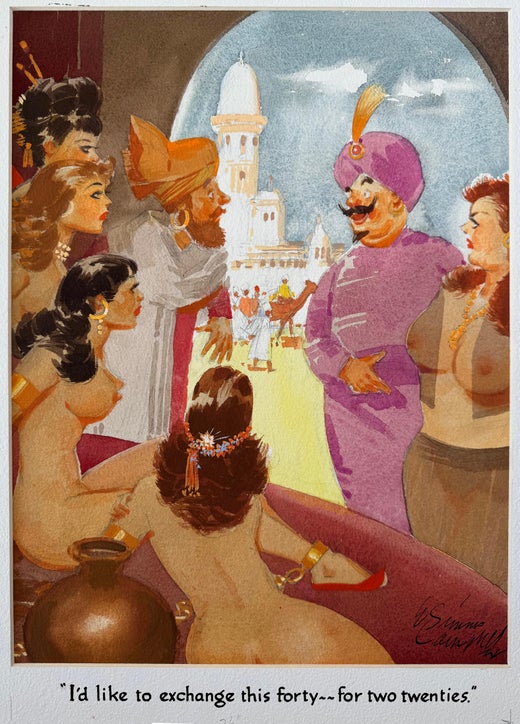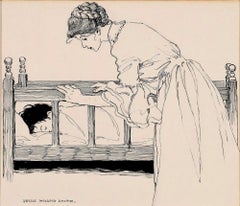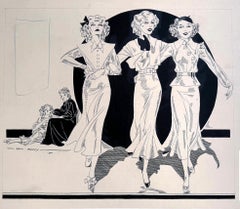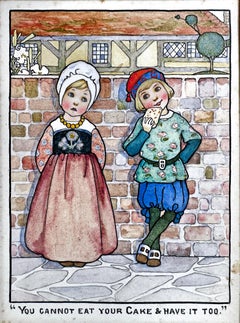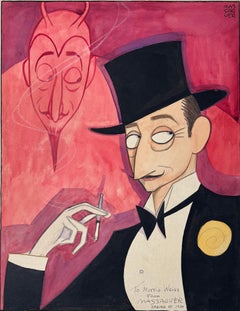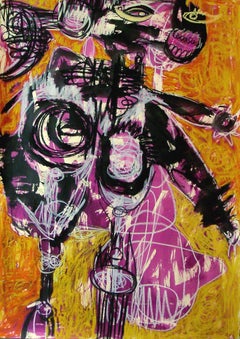Items Similar to My Husbands Former Girl Friends - First Black Illustrator/ Black Cartoonist
Video Loading
Want more images or videos?
Request additional images or videos from the seller
1 of 12
E. Simms CampbellMy Husbands Former Girl Friends - First Black Illustrator/ Black Cartoonist1941
1941
About the Item
Cuties Cartoon Strip - E. Simms Campbell
My Husband Former Girl Friends - First Black Illustrator/ Cartoonist,
- Creator:E. Simms Campbell (1906 - 1971, American)
- Creation Year:1941
- Dimensions:Height: 13 in (33.02 cm)Width: 8.5 in (21.59 cm)
- Medium:
- Movement & Style:
- Period:
- Condition:Overall Good minus Glue remnants.
- Gallery Location:Miami, FL
- Reference Number:1stDibs: LU385311104332
E. Simms Campbell
Elmer Simms Campbell (January 2, 1906 – January 27, 1971) was an American commercial artist best known as the cartoonist who signed his work, E. Simms Campbell. The first African-American cartoonist published in nationally distributed, slick magazines, he created Esky,the familiar pop-eyed mascot of Esquire. Campbell was born in St. Louis, Missouri, the son of educators, Elizabeth Simms Campbell & Elmer Campbell
He then enrolled in the University of Chicago. After one year, Campbell left the University of Chicago and transferred to and received his degree from the Chicago Art Institute.
He spent two years at Triad Studios before moving to New York City in 1929. taking classes at the National Academy of Design. During this time, he contributed to various magazines, notably Life, & Judge.
Following the suggestion of cartoonist Russell Patterson to focus on good girl art, Campbell created his "Harem Girls", a series of watercolor cartoons that attracted attention in the first issue of Esquire, debuting in 1933. Campbell's artwork was in almost every issue of Esquire from 1933 to 1958 & he was the creator of its continuing mascot, the cartoon character in a silk top hat.
He also contributed to The Chicagoan, Cosmopolitan, Ebony, The New Yorker, Playboy, Opportunity: A Journal of Negro Life, Pictorial Review, and Redbook.
His commercial artwork for advertising included illustrations for Barbasol, Springmaid,Hart Schaffner & Marx.
Campbell also was the author of a chapter on blues music in the 1939 book Jazzmen, a seminal study of jazz's history and development.
Campbell died in White Plains, New York, in 1971
His gag panel, Cuties, was syndicated by King Features in more than 145 newspapers "A Night-Club Map of 1930s Harlem"
Of enduring cultural & historical interest is the witty, cartoon-filled map Campbell drew in 1932 – "A Night-Club Map of 1930s Harlem" identifying the attractions of Harlem during the Harlem Renaissance and adding his personal notes. He captures the intensity of the scene: within a few blocks of each other he has cartooned Cab Calloway singing at the Cotton Club, Bill "Bojangles" Robinson doing his step dance at the Lafayette Theater – "Friday night is the Midnight show, Most Negro revues begin and end here." Lissome "cafe au lait girls" dance at Small's Paradise. Outside, doormen welcome White swells in top hats, while an elegant Black couple in evening dress dance "the Bump"
Campbell's map appears in the book version of Ken Burns's documentary Jazz. The map in its entirety also appears as the inside front cover of "Of Minnie the Moocher and Me", the autobiography of Cab Calloway by Cab Calloway and Bryant Rollins (TY Crowell, 1976). Jazz historian Mike Thibault reports that the original was displayed by the Smithsonian in 1996.The map is currently held at the Yale Beinecke Rare Book & Manuscript Library.
On April 4, 2017, National Geographic published an article on the map that included the map and several enlarged sections of it. They featured it again during 2020 to subscribers of their newsletter, among a collection of unique maps of New York City.
Recognition

About the Seller
4.9
Vetted Professional Seller
Every seller passes strict standards for authenticity and reliability
Established in 2005
1stDibs seller since 2016
113 sales on 1stDibs
Typical response time: <1 hour
- ShippingRetrieving quote...Shipping from: Miami, FL
- Return Policy
Authenticity Guarantee
In the unlikely event there’s an issue with an item’s authenticity, contact us within 1 year for a full refund. DetailsMoney-Back Guarantee
If your item is not as described, is damaged in transit, or does not arrive, contact us within 7 days for a full refund. Details24-Hour Cancellation
You have a 24-hour grace period in which to reconsider your purchase, with no questions asked.Vetted Professional Sellers
Our world-class sellers must adhere to strict standards for service and quality, maintaining the integrity of our listings.Price-Match Guarantee
If you find that a seller listed the same item for a lower price elsewhere, we’ll match it.Trusted Global Delivery
Our best-in-class carrier network provides specialized shipping options worldwide, including custom delivery.More From This Seller
View AllMother and Child, Golden Age of Illustration
By Jessie Willcox Smith
Located in Miami, FL
America's greatest female illustrator draws a heartwarming picture of a mother putting to bed her child. Motherly love towards their children is the artist's most iconic theme. This ...
Category
Early 1900s Art Nouveau Figurative Drawings and Watercolors
Materials
Ink, Illustration Board, Pen
The Three Graces Fantasy Fashion Illustration - Female Illustrator
Located in Miami, FL
For your consideration, we have a pen and ink drawing of an interpretation of The Three Graces, who strike a pose for a 1930s fashion ad. In Greek mythology, they were goddesses w...
Category
1930s American Impressionist Figurative Drawings and Watercolors
Materials
India Ink, Board
The Wise Book Children's Book Illustration- Woman Illustrator - Arts and Crafts
Located in Miami, FL
This little gem of a compact artwork was executed in the Arts and Crafts style for an interior illustration for "The Wise Book," J.M. Dent & Co, London, 1906.
"You can't eat your ca...
Category
Early 1900s Victorian Figurative Drawings and Watercolors
Materials
Ink, Watercolor, Gouache, Board
Cuban Artist - Caricature of Adolphe Menjou Debonair Devil
Located in Miami, FL
Framed Cuban Artist/Caricaturist Conrado Walter Massaguer presents Hollywood star Adolphe Menjou in a satirical dual portrait. In the foreground, the subject is seen in a dapper top hat, tux, fashionable cigarette and boutonnière, and is shown as being the epitome of being stylishly debonair. To make a larger point about this subject, Massaguer paints a cast shadow of Menjou as a burning red devil who studies his alter ego from above. Keeping with the artist's sarcasm, we see the good and bad in one image. Works by Massaguer are rare and this work is in keeping with his signature style. This work was most likely done on assignment for Life Magazine, Cosmopolitan, The New Yorker or Vanity Fair. Signed upper right. Inscribe lower right. Titled on verso. Unframed, Slight bend to board; toning to board; scattered faint foxing; pin point abrasions to margins, not affecting image. 19-1/2 x 15-1/8 inches board size.
Conrado Walter Massaguer y Diaz was a Cuban artist, political satirist, and magazine publisher. He is considered a student of the Art Nouveau. He was the first caricaturist in the world to broadcast his art on television.He was first caricaturist to exhibit on Fifth Avenue. He was the first caricaturist in the world to exhibit his caricatures on wood. He, and his brother Oscar, were the first magazine publishers in the world to use photolithographic printing.
Self portrait of Conrado Walter Massaguer, depicted on a carrousel ride, with the devil over his left shoulder and an angel over his right. (1945)
He created the magazine Social with his brother Oscar to showcase Cuban artistic talent. The duo later created the magazine Carteles, which became for a period the most popular magazine in Cuba, which was purchased by Miguel Ángel Quevedo in 1953.
In his life, he met and drew caricatures of Franklin D. Roosevelt, Walt Disney, Albert Einstein, the King of Spain, and many others.[ In sum total, he was the author of more than 28 thousand caricatures and drawings.Ernest Hemingway once had to refrain himself from punching Massaguer in the face after the artist drew an unflattering caricature of him. The dictator Gerardo Machado, however, did not punch Massaguer for his own unflattering caricature - he had the artist deported.
He was one of the most internationally renowned Cuban artists of his day, and his art is still regularly featured in galleries across the Western Hemisphere and Europe.
Early life
Massaguer was born on October 18, 1889, in Cárdenas, Cuba.[In 1892, his family moved to Havana.
When the Cuban War of Independence broke out, Massaguer's family escaped the country. From 1896 to 1908, he lived in Mérida, Mexico. However, during this time, his parents enrolled him in the New York Military Academy, where he stayed during school years.
In 1905, after graduating the military academy, he briefly attended the San Fernando school in Havana, where he was tutored by Ricardo de la Torriente and Leopoldo Romañach.
In 1906, less than a year later, he returned to the family home in Mexico.
Career as artist
Early career
While living in Yucatán, Mexico, Massaguer published his first caricatures in local newspapers and magazines. These included La Campana, La Arcadia, and the Diario Yucateco.
In 1908, he moved back to Havana. After returning to the island in 1908, Massaguer began mingling with Havana's aristocratic circles, forming close friendships with some of the city's most powerful and influential men, as well as winning the favor of many women who were quickly charmed by him. Massaguer, largely self-taught, honed his style using the avant-garde techniques he studied from the European and American magazines that were widely available in Cuba at the time.
Cover of the immensely popular Cuban magazine El Figaro, drawn by Massaguer in 1909. This cover depicts two bumbling, incompetent American tourists to the island.
He started drawing for El Fígaro, and was featured prominently on the cover in 1909.
After two years of refining his craft, Havana announced a poster contest aimed at attracting North American tourists to stay in the city during the winter months. Notable figures like Leopoldo Romañach, Armando Menocal, Rodríguez Morey, Jaime Valls, and others also entered the competition. The jury was particularly impressed by the modern execution and creative solution of one piece, signed by Massaguer, who was relatively unknown at the time.
The jury deliberations caused a great controversy.[5] The prize was ultimately awarded to the Galician painter Mariano Miguel, who had recently married the daughter of Nicolás Rivero, the wealthy owner of the conservative newspaper Diario de la Marina. Although Massaguer received only an honorable mention, the fraud scandal caused such an uproar that his name quickly entered the public spotlight, and he became an overnight sensation.
In 1910, he became co-owner of the advertising agency Mercurio, with Laureano Rodríguez Castells. At Mercurio, he led the Susini cigar campaign, and earned substantial wealth.
Massaguer has been described as a restless man, in both mind and body.After earning enough money from his art to begin traveling, he was almost always doing so. He constantly traveled between New York City and Havana, Mexico and France, Europe and the Americas.
In 1911, his reputation among the Havana socialites solidified when he organized his own first public caricature exhibit, and also the first Caricature Salon ever held in the Americas, hosted at Athenaeum of Havana (the Ateneo), and the Círculo de La Habana. Other exhibitors here included Maribona, Riverón, Portell Vilá, Valer, Botet, Barsó, García Cabrera, Carlos Fernández, Rafael Blanco, and Hamilton de Grau.
"Messaguer Visits Broadway." Caricatures of theatrical and literary figures. Elsie Janis, Raymond Hitchcock, S. Jay Kaufman (columnist), Ibanez, author of The Four Horsemen, and Frances White
In 1912, in the New York American Journal, he published his first Broadway drawings.
From 1913 to 1918, he was an editor for Gráfico.
Social
Main article: Social (magazine)
Cover of the magazine Social, July 7, 1923
In 1916, he created the magazine Social with his brother, Oscar H. Massaguer. Social's contributors included Guillén Carpentier, Chacón y Calvo, Enrique José Varona and others.Social has been described as Massaguer's great love in the magazine industry, and was the property that historians say he cared the most about. Social was an innovative magazine, being the first magazine in the world to use a modern printing process called photolithographic printing.
Social set cultural trends, not only in the fashion of Cuba, but in art, politics, and Cuban identity.[11] Social catered to a certain aesthetic in Cuba - that of the sophisticated elite socialite - but Massaguer would also use this magazine to ridicule and jibe against that same class of society when he found their personalities worthy of his contempt.
In Social, readers could find a variety of content, including short stories, avant-garde poetry, art reviews, philosophical essays, and serialized novels, as well as articles on interior design, haute couture, and fashion. Occasionally, the magazine also featured reports on sports such as motor racing, rowing, tennis, and horse riding.The cultural promotion efforts of both Massaguer and Emilio Roig de Leuchsenring are evident in the magazine. Notably, this period overlaps with their involvement in the Minorista Group, which was then at the forefront of the country's intellectual life.[5] Many contributors were devoted members of the group, leading some experts to consider Social as the cultural voice of the Minoristas.
One of the features of Social magazine was its section called "Massa Girls," which was a play on his own name, and pronounced with a glottal 'g' in a similar fashion to the letter in Massaguer.[12] Massaguer drew women as independent and free-thinking, and never drew the woman celebrity as a caricature of herself, but as a free agent surrounded by caricatures.[11] However, Massaguer himself has been described as a womanizer in his personal life, and hesitant to fully embrace every facet of women's liberation.
In 1916, he also established la Unión de Artes Gráficas and the advertising agency Kesevén Anuncios.[9]
The art critic Bernardo González Barroa wrote:
“Massaguer has solved the problem of working hard, living comfortably off what his art produces and not missing any artistic, sporting or social event. His broad, childish laugh, of a carefree individual who carries his luck hidden in a pocket, appears everywhere for the moment, disguising the pranks of pupils that lurk, mock and, finally, flash with satisfaction at finding the characteristic point after having analyzed a soul... Massaguer's personality is beginning to solidify now. He has been the best-known and most popular caricaturist for a long time, but his technique had not reached the security, the mastery of values that he presents in his latest works, which is very natural and explainable”[5]
Carteles
Main article: Carteles
Cover of the magazine Carteles, November 29, 1931
In 1919, Massaguer and his brother created the magazine Carteles.[9] Carteles gained the widest circulation of any magazine in Latin America, and the most popular magazine in Cuba for a time, until that title was claimed by Revista Bohemia. Carteles remained in print until July 1960.This magazine showcased Cuban commerce, art, sports, and social life before the revolution.
In 1924, Carteles took a more political turn, with articles criticizing Gerardo Machado's government. it became a prime example of the humor and graphic design employed by artists like Horacio Rodríguez Suria and Andrés García...
Category
1930s Art Nouveau Portrait Drawings and Watercolors
Materials
Watercolor, Ink, Illustration Board
Snappy Answers to Stupid Questions - Mad Magazine -Table for How Many Restaurant
Located in Miami, FL
"Snappy Answers to Stupid Questions" is one of Al Jaffee's signature series. This work was a double-page work that appeared on pages 60 - 61 in Mad Magazine in 1968. Although this w...
Category
1960s Conceptual Figurative Drawings and Watercolors
Materials
Ink, Gouache, Illustration Board, Pen
The Bully - Narrative Art by Female Illustrator Golden Age of Illustration
By Maginel Wright Enright Barney
Located in Miami, FL
The present work exhibits a storytelling and illustration art style created before the mass communications age. It was rendered in a flat linear style by the highly talented Maginel ...
Category
1910s American Impressionist Figurative Drawings and Watercolors
Materials
India Ink, Watercolor, Board
You May Also Like
Signed Feminist LGBTQ+ Ink on Paper Drawing - Profile Flying 446.003
Located in New York, NY
Linda Stein, Profile Flying 446.003 - Signed Feminist LGBTQ+ Ink on Paper Drawing
Profile Flying 446.003 is from Linda Stein's Profiles series--drawings, collages and paintings of...
Category
1970s Contemporary Figurative Drawings and Watercolors
Materials
Ink, Board
$2,800 Sale Price
20% Off
"The Crowning With Thorns" Contemporary Ink Drawing
By Paul Rossi
Located in Brecon, Powys
I work in oils, goauche, charcoal, pencil, pen and ink, and less frequently, in acrylic and watercolour. My work takes a figurative approach to space and tends to revolve around the ...
Category
2010s Contemporary Figurative Drawings and Watercolors
Materials
Ink, Board
Untitled - Parmis Sayous 21st Century drawing, Iranian contemporary painter
By Parmis Sayous
Located in Paris, FR
Pastel and India ink on cardboard
Created in 2019 in Paris, France
Unique work
Signed by the artist
Parmis Sayous was born in 1982 in Teheran, Iran.
Since 2015, She has lived and wo...
Category
2010s Expressionist Figurative Drawings and Watercolors
Materials
Pastel, India Ink, Cardboard
Untitled - Parmis Sayous 21st Century drawing, Iranian contemporary painter
By Parmis Sayous
Located in Paris, FR
Pastel and India ink on cardboard
Created in 2019 in Paris, France
Unique work
Signed by the artist
Parmis Sayous was born in 1982 in Teheran, Iran.
Since 2015, She has lived and wo...
Category
2010s Expressionist Figurative Drawings and Watercolors
Materials
Pastel, India Ink, Cardboard
Untitled - Parmis Sayous 21st Century drawing, Iranian contemporary painter
By Parmis Sayous
Located in Paris, FR
Pastel and India ink on cardboard
Created in 2019 in Paris, France
Unique work
Signed by the artist
Parmis Sayous was born in 1982 in Teheran, Iran.
Since 2015, She has lived and wo...
Category
2010s Expressionist Figurative Drawings and Watercolors
Materials
Pastel, India Ink, Cardboard
The Moonslayer - Parmis Sayous 21st Century drawing Iranian contemporary painter
By Parmis Sayous
Located in Paris, FR
Pastel and India ink on cardboard
Created in 2019 in Paris, France
Unique work
Signed by the artist
Parmis Sayous was born in 1982 in Teheran, Iran.
Since 2015, She has lived and wo...
Category
2010s Expressionist Figurative Drawings and Watercolors
Materials
Pastel, India Ink, Cardboard
Recently Viewed
View AllMore Ways To Browse
Vintage Cartoons
Richard Dighton
Theadius Mccall
William Henry Hunt On Sale
Dewitt Hardy
Edouard Halouze
Gil Froidevaux
Mady Dormans
Margaret Mousseau
Phelan Gibb
Victor Ambrus
Vintage Smiths Timer
Figurative Contemporary Painters
Horses In Art
Painting Of Mexico
Abstract Art Orange
Pop Art Signed Print
Small Landscape Painting
